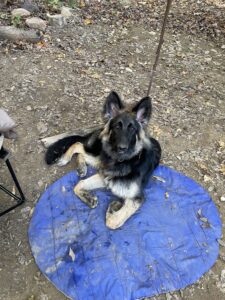Every dog’s behavior modification journey is different, but that doesn’t mean they don’t share very similar frameworks. When you work with us, here’s the basic blueprint you can expect:
1. Prevention
First we prevent practice of the feelings and behaviors we are trying to eliminate via management. You can think of it like behavioral training wheels. This is first on our list for a few reasons:
- It gives immediate stress relief – for everyone.
- No more reactions, no more big feelings, no more adrenaline.
- Practice makes permanent.
- If your dog keeps practicing the same behaviors we are trying to eliminate, we are never going to make forward progress.
- Being constantly adrenalized prevents learning.
- If your dog is in fight-or-flight from being triggered on the regular, they aren’t going to be able to learn new skills very effectively. Give them a break from the stress so they have a chance to learn the skills we are trying to teach.
2. Activity Adjustments
Under-exercising your dog can contribute heavily to major behavioral issues. Dogs have a basic need to move through space, use their bodies, and use their brains. The goal here is to satisfy – not exhaust.
You can’t out-train a lack of exercise – physical or mental.
Even if your dog’s behavior problem isn’t directly caused by lack of exercise & enrichment, mindfully increasing their activity level can increase their stress tolerance – and reduce behavioral problems.
3. Wellness
How we feel physically impacts how we feel mentally and emotionally – and how we behave. Just like humans, dogs get cranky and irritable when they don’t feel good.
Just like you can’t out-train a lack of exercise, you can’t out-train pain, discomfort, or physiological concerns.
When it comes to wellness, your vet is your best resource. If you or your trainer suspects pain, take clear note of the signs and bring your concerns to your vet.
Dogs don’t speak human and they don’t often clearly communicate their pain or discomfort, so you may need to do some sleuthing. Pay close attention to body language, gait, hesitance, refusal of cues, unexplained change in diet or exercise, or any other unexplained behavior issues. If there’s no obvious smoking gun for a new behavioral concern, it’s time to go to the vet.
4. Skill Building
Once Prevention, Activity, and Wellness are addressed – it’s time for Skill building (P-A-W-S).
Skill building is a combination of teaching your dog skills and learning how to deploy them. When we skill build, we start in a distraction-free area with a motivator your dog is happy to work for – food, toys, praise, etc. As they get good at their new skills, we add challenge by taking our training in the yard and around the neighborhood – until you and your dog are skilled enough to face some triggers.
Teaching a dog “Leave it!” doesn’t fix resource guarding or reactivity – but it is an absolute game changer for reducing it’s impact when it’s used well.
5. Reducing Management
As your dog gets good at using their skills and their response to triggers decreases – it’s time to take off the training wheels.
- If your dog regresses, has a bad day, or just isn’t feeling it – add management.
- If your dog is doing very well – add more challenge by reducing management.
Continue to reduce management until you find yourself in a sustainable balance between management and training.
Some people choose lifelong management – and that’s okay! Others may choose to focus heavily on training and eliminate as much management as possible – the training equivalent of driving defensively.
6. Graduation & Maintenance
You did it! You’re at a sustainable place, and you feel well equipped with the tools you need to handle anything life throws at you. And if you get any really wild curveballs and don’t know what to do – we are always here to help.



